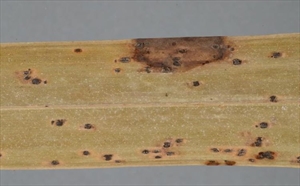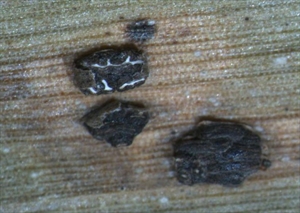Coconut false rust, coconut leaf smut
Pacific Pests, Pathogens, Weeds & Pesticides - Online edition
Pacific Pests, Pathogens, Weeds & Pesticides
Coconut false smut (311)
Graphiola cocoina. Another species, Graphiola phoenicis is also present in the Pacific islands, in Fiji and Samoa.
South (India) and Southeast Asia, South America (Brazil), Oceania. It is recorded from Cook Islands, French Polynesia, Marshall Islands, New Caledonia, New Zealand, Niue, Samoa, Tonga, and Vanuatu.
Graphiola cocoina infects coconut and Livistona species. Graphiola phoenicis infects a wide range of palms; it infect coconuts, but the main hosts are Phoenix canariensis (Canary Island date palm) and Phoenix dactylifera (date palm).
Although called a leaf 'smut', it is not a true smut (e.g., see Fact Sheet no. 46), and belongs to a different taxonomic class. Small, grey or black pustules, 1.5 mm diameter, emerge through the leaf, mainly on the top surface (Photo 1). They protrude some distance above the leaf surface, and produce the spores and sterile threads of the fungus (Photo 2). After discharge the pustules become cup-shaped.
Spread occurs by spores blown in the wind and rain. Humid conditions promote the development of the disease as the spores need water for germination and infection.
It is very unlikely that the false smut would impact nut yield. It occurs on the oldest leaves of the palms. It is possible that it might be considered a cosmetic disease where coconut palms are grown for landscaping (i.e., for their appearance) rather than their nut production.
Look for the black pustules that erupt through the surface of the leaves, mainly on the underside. The filaments that stream from the pustules are distinctive.
Attempts to control this disease on coconuts in a plantation would not be economic, especially as there is no evidence that it reduces nut yield. If the disease where to be severe in the nursery, then both cultural control and chemical control measure might need to be applied.
CULTUAL CONTROL
Ideally, nuts for germination should be planted in polythene bags and spaced at a distance which allows air movement around the plants, at least 1m. If nuts are left to germinate and grow on the ground, this is not possible. If seedlings in polythene bags need water, then it should be applied below the canopy.
CHEMICAL CONTROL
If fungicides were required in the nursery, use copper products or mancozeb as protectants, or thiophanate methyl (sometimes formulated with chlorothalanil) as a systemic product.
____________________
When using a pesticide, always wear protective clothing and follow the instructions on the product label, such as dosage, timing of application, and pre-harvest interval. Recommendations will vary with the crop and system of cultivation. Expert advice on the most appropriate pesticides to use should always be sought from local agricultural authorities.
AUTHORS Grahame Jackson & Eric McKenzie
Information and (including Photos 1&2) McKenzie E (2013) Graphiola cocoina: PaDIL - (http://www.padil.gov.au).
Produced with support from the Australian Centre for International Agricultural Research under project PC/2010/090: Strengthening integrated crop management research in the Pacific Islands in support of sustainable intensification of high-value crop production, implemented by the University of Queensland and the Secretariat of the Pacific Community.





